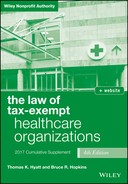CHAPTER ONE
Tax‐Exempt Healthcare Organizations—An Overview
- § 1.2 Defining Tax‐Exempt Organizations
- § 1.5 Charitable Healthcare Organizations
- § 1.10 ABLE Programs
§ 1.2 DEFINING TAX‐EXEMPT ORGANIZATIONS
p. 9. Insert as second paragraph:
The U.S. Supreme Court, reflecting these principles, wrote that a “nonprofit entity is ordinarily understood to differ from a for‐profit corporation principally because it ‘is barred from distributing its net earnings, if any, to individuals who exercise control over it, such as members, officers, directors or trustees.’”23.1 The Court has discussed the concept of nonprofit organizations on other occasions.23.2 (Of course, before there can be a nonprofit organization or a tax‐exempt organization, there must first be an organization.23.3)
§ 1.5 CHARITABLE HEALTHCARE ORGANIZATIONS
p. 15. Insert following existing text at note 79:
- Meanwhile, state courts continue to challenge the qualification of hospitals as charitable organizations for real property tax exemption purposes. In a 91‐page decision that describes the current structure and operations of the majority of hospitals in the United States, the New Jersey Tax Court revoked property tax exemption for Morristown Memorial Hospital. The court concluded that “[i]f it is true that all non‐profit hospitals operate like the Hospital in this case…then for purposes of the property tax exemption, modern non‐profit hospitals are essentially legal fictions.…Clearly, the operation and function of modern non‐profit hospitals do not meet the current criteria for property tax exemption under [New Jersey law.]” AHS Hospital Corp., d/b/a Morristown Memorial Hospital v. Town of Morristown, 2015 BL 206190 (N.J. Tax Ct. 2015). See generally, Paff, “Is Your Nonprofit Hospital's Property Tax Exemption Safe?,” Bloomberg Daily Report for Executives, August 25, 2015.
p. 22. Insert following existing material:
§ 1.10 ABLE PROGRAMS
The newest category of tax‐exempt organization, modeled somewhat on the state‐sponsored qualified tuition program,137 is the ABLE program.138 This is a program established and maintained by a state, or agency or instrumentality of a state, under which a person may make contributions for a tax year, for the benefit of an eligible individual, to an ABLE account that is established for the purpose of meeting the qualified disability expenses of the designated beneficiary of the account.139 A designated beneficiary may have only one ABLE account.140 A beneficiary must be a resident of the state that established the program or a resident of a contracting state.141 An interest in an ABLE program may not be used as security for a loan.142
An eligible individual is an individual entitled to benefits based on blindness or disability under the Social Security Act, where the blindness or disability occurred before the date on which the individual attained age 26, or a disability certification143 with respect to the individual is filed with the IRS.144 A designated beneficiary in connection with an ABLE account established under a qualified ABLE program is the eligible individual who established an ABLE account and is the owner of the account.145 The term disability expenses means expenses related to the eligible individual's blindness or disability that are made for the benefit of an eligible individual who is the designated beneficiary, including expenses for education, housing, transportation, health, financial management services, and legal fees.146
Contributions to an ABLE account must be in the form of money.147 There is an annual per account funding limit equal to the annual gift tax exclusion.148 A qualified ABLE program must provide a separate accounting for each designated beneficiary.149 A beneficiary may, directly or indirectly, direct the investment of contributions to the program, and earnings thereon, no more than two times in any calendar year.150 Distributions from a qualified program are not includable in the beneficiary's gross income to the extent they do not exceed the amount of qualified disability expenses.151
Each officer or employee having control of the qualified ABLE program or their designee must make reports regarding the program to the IRS and to designated beneficiaries with respect to matters such as contributions, distributions, and the return of excess contributions.152 For research purposes, the IRS must make available to the public reports containing aggregate information, by diagnosis and other relevant characteristics, on contributions and distributions from qualified ABLE programs.153
